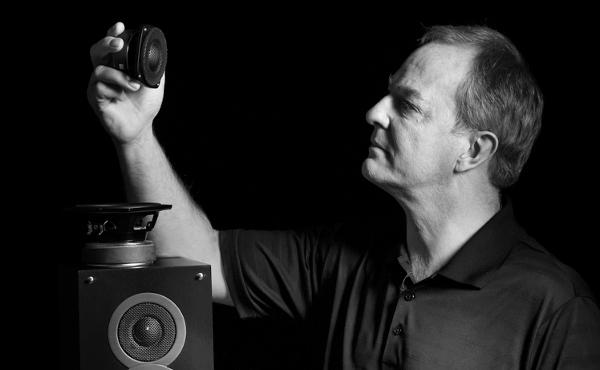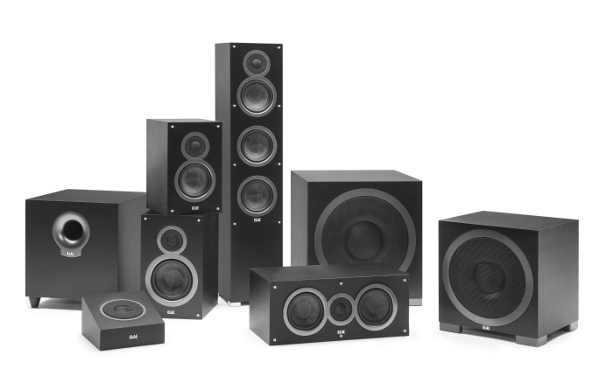I love this democratization of high-end audio being brought about by Andrew Jones and others with his audio values. Especially as turntable sales continue to trend upward, quality in the rest of the playback chain will once again become a mainstream concern, and the speakers will naturally be the main focus. If $240/pr gets you the real deal, and if the forthcoming $500-ish ELAC integrated is on display driving the speakers, that makes is really easy to get the whole package and have hifi sound like only a tiny fraction of the population has ever heard. I hope it catches on!
Man on a Mission: Speaker Designer Andrew Jones

S&V: You were at Pioneer for more than 17 years. That’s a long time. Tell us about the transition to ELAC.
Andrew Jones: Yes, it is a long time. Pioneer was a great experience. I joined because of what I knew about Pioneer research capabilities through the years, with the view of being able to access materials and technologies that would be unavailable to most high-end speaker companies. This bore fruit with what I was able to do with TAD. However, life changes, and so does Pioneer. With its recent re-structuring I began to entertain thoughts of potentially a different future. When ELAC approached me with the idea of expansion and heading up a new design facility, it was an offer I couldn’t refuse.
S&V: Can you provide a little background on ELAC and tell us how you fit in?
AJ: ELAC celebrates its 90th birthday next year, and introduced its first hi-fi product in 1948, a turntable. It became a leader in turntable manufacturing by 1957, and holds the patent for the first stereo moving-magnet cartridge. In more recent times, with loudspeakers that feature the JET tweeter (a Heil type ribbon driver), ELAC has become recognized as a major player in high-end audio. It’s this heritage that persuaded me to join forces with them.
 Although well known in the U.S. in the past for the Miracord turntables, in recent years the company has not been very visible here, known only to those that take an interest in European brands. However in Europe, ELAC is very well regarded and has garnered an astonishing number of very favorable reviews and a strong and enthusiastic following. The idea behind setting up a new design facility is many fold: to expand the product range both upwards and downwards; to refine existing technologies and develop new ones; to introduce new product categories; and to re-invigorate the U.S. market.
Although well known in the U.S. in the past for the Miracord turntables, in recent years the company has not been very visible here, known only to those that take an interest in European brands. However in Europe, ELAC is very well regarded and has garnered an astonishing number of very favorable reviews and a strong and enthusiastic following. The idea behind setting up a new design facility is many fold: to expand the product range both upwards and downwards; to refine existing technologies and develop new ones; to introduce new product categories; and to re-invigorate the U.S. market.
S&V: What are your goals for the aptly named Debut speaker series?
AJ: The Debut line is the beginning of a whole range of product. We are going to be very busy! The concept was to start with entry-level price points and try to bring extraordinary value to a category that is the entry point for (hopefully) new enthusiasts. When all of us old fogies in the industry gather together, we continually moan about the lack of young blood, yet we don’t seem to be doing much to fix that. We are not designing product that appeals either in price point or functionality to younger listeners. The Debut series is intended to address the price/performance issue and to excite listeners to become interested in hi-fi as a worthwhile hobby. I also paid attention to the industrial design, as it is a fact of life that if you are to attract new listeners, you won’t do that with hair shirt looks!
I constantly refer to an internalized standard of what I want to hear from a speaker. I realize that TAD levels of performance are not possible at these price points, but an essence of it is, and it is that essence that I am looking to achieve.
S&V: With prices ranging from $230 to $560 a pair, the five-model lineup is easy on the wallet and reminiscent of the work you did at Pioneer in recent years. What makes these speakers special…what sets them apart?AJ: The line is only reminiscent of the Pioneer speakers in its objectives. In its detail design, there is no commonality. This was a ground up development effort. To this end, I took care to look at every detail of the design that costs money, and then decide what value that detail brings to the sound quality. By saving on some factors I could afford others, such as woven Aramid cones not normally found at these price points. The key is attention to detail and setting a high goal for the expected performance level. My years spent in the ultra-high end with TAD has a large part to play in this. I constantly refer to an internalized standard of what I want to hear from a speaker. I realize that TAD levels of performance are not possible at these price points, but an essence of it is, and it is that essence that I am looking to achieve. I am also guided by this when setting up demonstrations. I am never happy to make excuses for the environment. My job is to create a listening experience that shows just what is possible from a carefully set up system. This then acts as a guide to the potential purchaser to know what level of sound quality is ultimately available if he/she takes the time to optimize their home system.

S&V: Tell me about the equally affordable subwoofer lineup, especially the Auto EQ/Bluetooth app feature offered on two of the three models?
AJ: There are three models in the range. An entry-level subwoofer designed for value, but otherwise of traditional design. The two other models step up in performance, to a long throw 10- or 12-inch driver plus passive radiators. But in addition they add a unique feature for calibrating the subwoofer to the room. There are no controls on the subwoofer’s rear panel. They connect via low-energy Bluetooth to a smartphone or tablet. Via an app, you can control subwoofer level, phase, and crossover frequency.
In addition we have the ability to measure the response of the speaker in the room and apply correction for the room. We do this using the microphone built into the phone/tablet. No trailing cables from an auxiliary microphone! Now you might wonder how this can work since we don’t know what the response of the microphone is. It certainly is unlikely to have a flat extended low frequency response. Our process gets around this limitation.
If one measures a loudspeaker in its near field (within inches of the driver), the response is unaffected by the room. It measures very similar to the anechoic performance. It’s a trick designers use to avoid the need for a true anechoic chamber. We start by placing the phone very close to the subwoofer and running a calibration response, then move the phone to the listening position and re-measure. Then using built-in DSP we apply filters to adjust the room response to match what we measured for the near-field response. The in-room response now matches the designed response of the speaker. At the same time, the microphone’s actual response has been made irrelevant, we have essentially calibrated for the microphone.
T.H.E. Show Newport was a very interesting experience. The fun part was seeing peoples’ reaction to the sound performance. I was told many times that I would need a bodyguard to protect me from other speaker designers.
S&V: You very successfully previewed the B5 bookshelf speaker at T.H.E. Show (held in California at the end of May). What was it like to demonstrate speakers that will sell for $230 a pair at an exhibition dominated by two-channel exotica? I’m thinking some of the companies down the hall might not have been too happy…AJ: T.H.E. Show Newport was a very interesting experience! I knew I had something special with the speakers before arriving at the show, but by the time I had got them set up and dialed in (meaning trying every which way and direction in the room until it was optimized) I was extremely excited with what I was able to demonstrate. That was the fun part, seeing peoples’ reaction to the sound performance. Yes, there was the expected “where is the subwoofer” with people literally moving the drapes to search for one, but beyond that was the surprise on their faces at the low cost for such great performance. I was told many times that I would need a bodyguard to protect me from other speaker designers. Luckily my partners are 6’5” and 6’7”. I have no worries there!!
S&V: I understand the speakers are designed in a new facility in Southern California. Where are they manufactured?
AJ: As part of the ELAC organization, we have R&D facilties both in Kiel, Germany and now in Cypress, California. I work primarily out of the California facility where I have set up all new measurement and design capability, but I also work with the team in Germany. The Debut series are designed in our California facility, and built in China by a manufacturing partner that I have years of experience with and that has a proven process and quality capability. The higher end speakers currently offered from ELAC are built in our factory in Germany.
S&V: How and where will the speakers be sold? And when will they be available to consumers?
AJ: Hopefully the speakers will be sold everywhere!! We are currently setting up all our distribution and sales channels. Availability will be mid-September. We have also added pre-order capability on our website (elac.us)
S&V: What’s next? I hear you will be venturing into higher end territory at some point.
AJ: We have all sorts of products in the pipeline, in process of development, as well as thoughts for future products. I also intend to re-enter the high end market, and bring the same kind of value that I have achieved at the entry level. I think you will be very surprised at what we will be launching in the near future.
- Log in or register to post comments






























































